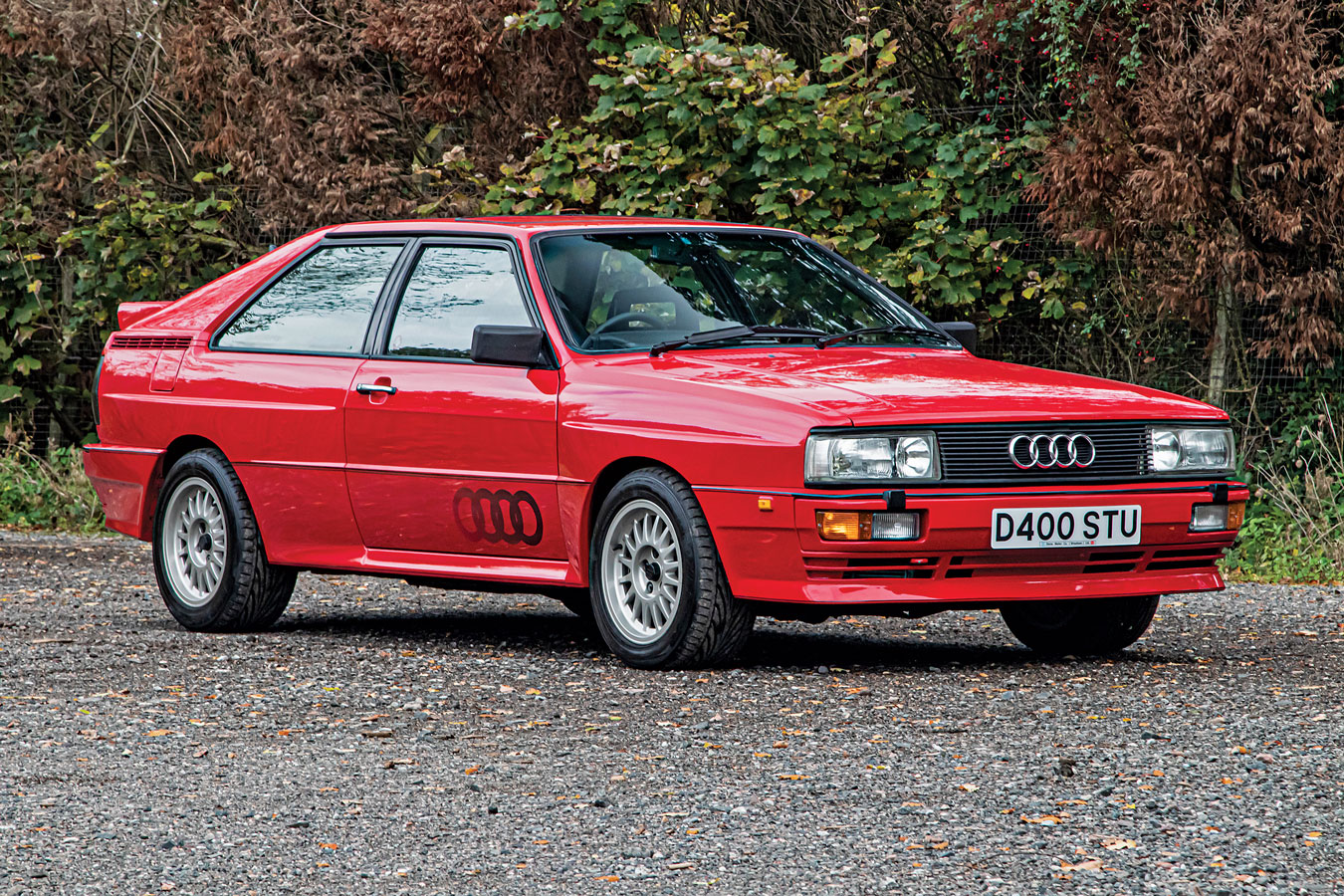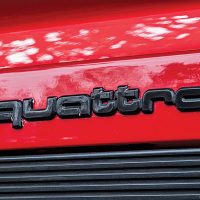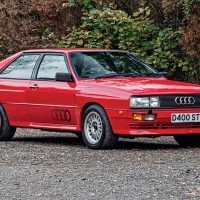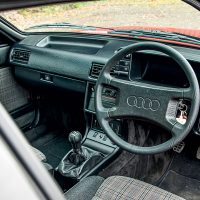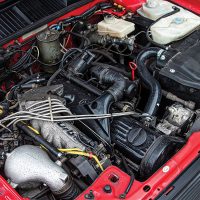SCM Analysis
Detailing
| Vehicle: | 1987 Audi Quattro |
| Years Produced: | 1980–91 |
| Number Produced: | 11,452 |
| SCM Valuation: | $39,000 |
| Tune Up Cost: | $200 |
| Chassis Number Location: | Firewall identification plate |
| Engine Number Location: | Right-side engine block underneath spark plugs |
| Club Info: | Quattro Owners Club, Audi Club of North America |
| Website: | http://www.quattroownersclub.com |
| Alternatives: | 1967–80 Ford Escort, 1980–86 Renault 5 Turbo, 1992–2000 Subaru Impreza WRX |
This car, Lot 224, sold for $47,427 (£36,000) at Silverstone’s NEC Classic Live Online Auction on November 13, 2020.
For the U.S. market, the Audi Quattro was based on the Audi Coupe, itself a derivative of the Audi 4000 sedan. The front-drive Coupe carried an adequate but not-going-to-set-the-world-on-fire 2.2-liter 5-cylinder engine, producing 100 naturally aspirated horsepower. At its introduction in 1980 (for the 1981 model year), its base price of $11,875 was Audi’s most expensive, which kept sales modest at best. Just 2,553 units were sold the first year.
The U.S. didn’t get the Quattro quite yet, but in Europe it debuted alongside the Coupe in 1980. The capital “Q” differentiated the car from the all-lowercase quattro all-wheel-drive system itself.
A late arrival
Audi finally brought the Quattro coupe to America in the spring of 1982 as a 1983-model-year vehicle. Its turbocharged SOHC 5-cylinder was good for 156 horsepower and 181 foot-pounds of torque. A 5-speed manual transmission was standard, and the running gear was upgraded from the Coupe.
However, Audi did not make it easy to sell the Quattro, pricing it at $35,000. That was over $10,000 more than the brand-new C4 Corvette, or about the same as Porsche’s top-trim 911 SC.
It didn’t help that the concept of full-time all-wheel drive was yet unknown in the consumer sector. Although AMC was dabbling in the technology with the Eagle wagon — arguably the first crossover SUV — it was far from certain that American buyers would see the need for, much less buy, an AWD sports car.
Audi sold the Quattro here for four years, moving just 664 of them from 1983 to ’86. That was out of a total of 11,452 examples of the Ur-Quattro (“Ur” meaning “original” in German) constructed through 1991. Most of the rest were sold in Europe, including our subject car.
Know that Audi Quattro coupes are not the same as the Audi Sport Quattro, which was the short-wheelbase homologation special for the FIA Group B World Rally cars. Just 214 of those were built from 1984 to 1986 and they’re worth a median of $434,000, according to the 2021 SCM Pocket Price Guide.
The Quattro legacy
Although Audi sold few Ur-Quattros in the U.S., the die was cast for the future of the brand. The quattro full-time all-wheel-drive system worked just as well on dry pavement as on any low-traction surface. It was something that no other manufacturer had and gave Audi the upmarket difference it had been looking for.
There really wasn’t much in-period competition. Volkswagen had essentially the same system, called Syncro, but only in its Vanagon vans, starting in 1986. AMC’s system used a separate transfer case, like a truck. Subaru was still using part-time 4-wheel-drive on its funky economy cars until 1988.
If you wanted an elegant AWD sports car in the era, Audi was it.
The usual suspects
Speaking to Ur-Quattro owners and experts indicates the strengths and failings of these cars are typical for the era. On the plus side, quattro was ahead of its time, including locking center and rear differentials. Plus, the sound of the 5-cylinder engine is hypnotic. However, the Quattro is prone to rust in all the usual places, specifically in and around the wheelwells and strut towers, and the sunroof, hinges, spare-tire well, battery box and footwells — pretty much anywhere with rubber seals or where water can pool.
“Finding a complete car with low rust and a matching engine is key,” says Tim Maskus of Newberry, MI. Maskus has a long history with road and rally Quattros. “Most parts are no longer available, so hoarding and collecting spares is part of the ownership experience.”
Electrical parts are a particular challenge, as many are long since out of production. Be prepared for long waits or big costs for parts if they need to be sourced. As is usually the case, searching out a complete running car and paying more for the best one you can find is advised.
But unmolested Quattros are scarce. George Achorn, Editor of the Audi Club’s Quattro magazine, observes, “When they got cheap, they got modified, typically with aero headlights, forward dating of grilles, Euro bumpers, body kits, gauges and other situations. The interiors also didn’t wear well, particularly the leather segments and the dashboards. The early cars especially used cheap plastic interior pieces, which often cracked.”
A well-loved example
Our subject car is a great example of the original Quattro, this one with right-hand drive for the U.K. market. By 1987, when this car was made, European output from the two-valve-per-cylinder engine was 197 horsepower, giving more lively performance. The low mileage and generally pristine presentation shown in the auction video tells us that this car has been treated well from new, and the sale price of $47,427 reflected that desirable condition.
The Quattro looks great with its box-flared wheelarches, and it offers exciting performance. As the original AWD sports car, it should only increase in desirability. Audi’s more recent successes in the U.S. market, such as the R8 and TT, certainly don’t hurt.
Trying to psychoanalyze the market is always a dangerous game, but looking at the SCM Platinum Auction Database, there are plenty of Quattros trading well above the median over the past three years. We’ll toss out a prediction that this Quattro will be considered well bought in the near future. ♦
(Introductory description courtesy of Silverstone Auctions.)
